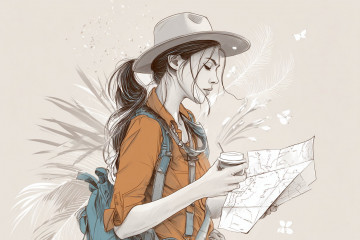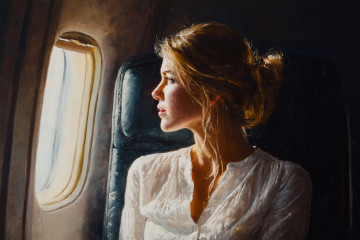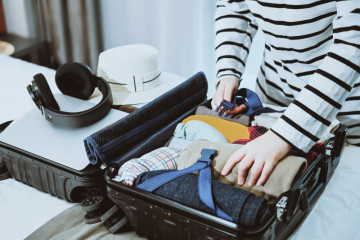Take it from the people who fly for a living: You can look stylish and still travel in comfort
The best way to dress for a flight
Figuring out what to wear on a plane can be as challenging as deciding what to pack. In fact, what you’re wearing is one of the first things flight attendants notice about you as you’re boarding. So how can you be comfortable both on the plane and when you arrive at your destination, all without sacrificing style? We went right to the source—a flight attendant—to find out the best rules to follow when you fly, including things flight attendants wouldn’t do on an airplane (like wearing stilettos).
“Remember, you are sitting in a piece of machinery with confined spaces, sharp objects and strangers,” says Amy Caris, a flight attendant and the Director of In-Flight at JSX, a “hop on” jet service. “Don’t wear your best outfit, but wear something that is comfortable and can slightly stretch. Comfort can be stylish!”
Stretchy pants
Space is already at a premium on a plane, so you don’t want to add anything that will make you feel even more confined. This is not the time for skintight jeans (although you may want to carry a jean jacket). “As a passenger, I always wear ponte knit pants, which offer stretch and are stylish,” says Caris. “You can even find jeans that have stretch to them.”
Breathable tops
When choosing what to wear on a plane, look for stylish tops made with natural fabrics, such as cotton, silk, wool or linen, which will allow air and moisture to pass through. Moisture-wicking man-made fabrics are an equally savvy option. “I avoid wearing synthetic polyester or rayon materials, as they retain body odor more quickly,” says Caris. “I like breathable tops that are just loose enough to keep my shape but are comfortable for sitting.”
Compression socks
Sitting for a long time can restrict blood flow and make your legs swell. Compression socks are designed to help combat leg and foot soreness as well as prevent deep-vein thrombosis (DVT), or blood clots in the legs. Thankfully, they are so much more fashionable than in the past. “Put them on before boarding,” Caris suggests, “because it can be a challenge to get them on in a confined space.”
Cardigans
Airplane dressing is all about layering. You never know if it’s going to be too hot or too cold when deciding what to wear on a plane, so a light cardigan is always a great choice. Caris suggests wearing your layers to avoid filling your carry-on bag space.
Long, stretchy dresses
You don’t have to trade in dresses for pants just because you’re flying. “I don’t recommend wearing skirts and dresses that are restrictive, but some knit dresses can be long, stretchy and easy to travel in,” says Caris. The best ones will keep you covered and comfy—and illustrate how clothes can affect your mood.
Comfy shoes
Flight attendants agree that the best shoes to wear on a plane are flats, although Caris points out that if you do prefer to wear heels, block heels are the most stable. Closed-toe shoes are best to protect your feet, as Caris learned the hard way. “I’ve broken my own rule and worn sandals before,” she admits. “As I was standing in the aisle waiting to get to my seat, the person in front of me backed up onto my foot and bent my nail back. Ouch. It was a good reminder as to why I should stick to my rules of flying!”
Wraps or shawls
A thick or lightweight cashmere or wool shawl not only adds flair to your outfit but does double duty on the plane as a blanket, pillow or extra layer, without taking up too much extra space in your carry-on bag. Just remember not to cover your seat belt with the wrap. “This way, [flight attendants] won’t need to wake you up if they’re required to conduct a compliance check during the flight,” says Caris.
Wrinkle-free business attire
If you’re traveling for business, you can save time and reduce stress about what to wear on the plane by dressing in your work outfit before you get on the flight. “It’s easy now to find business-looking yoga or stretchy pants and blazers for both men and women,” says Caris. “If you have to head straight to the office or a meeting after your flight, it’s not ideal to change in the lavatory or an airport bathroom stall. And it’s one less thing to worry about, especially if the flight gets delayed.”
Loose loungewear
If you’re flying overnight, it’s important to be able to get a few hours of sleep. But that doesn’t mean you should put on the same pajamas you would wear at home. Opt for loungewear, which looks as appropriate in public as it does in bed. “A nice pair of modal cotton sweats or a harem pant is acceptable,” says Caris. “Just make sure there are no holes in them!”
Slippers
To get comfortable and fall asleep, you’ll want to take off your shoes—but flight attendants warn against going to the lavatory without something on your feet. Although socks do provide a barrier between you and a dirty floor, they won’t protect you from wet spots—and you don’t want to spend hours with wet socks on your feet. A pair of easy-to-tote slippers, preferably with a rubber sole, will do the trick and will come in handy in a hotel room, as well.
What not to wear on a plane
Knowing what not to wear on a plane can be as important as knowing what to wear. Here are the items flight attendants suggest you leave home or save to wear post-flight:
Jewelry or bulky accessories
Metal will slow you down at security—it’s one of the things more likely to get you flagged by the TSA. Jewelry that can be hard to remove will also slow you down in the TSA line. Any jewelry shaped like a potential weapon also raises red flags and may be uncomfortable when you’re trying to lean back and get some shut-eye. Be careful with earrings too; they can easily fall off and get lost while you’re putting on or taking off headphones to watch a movie. “You don’t want to wear hoops that can get caught and pull on your ear lobe,” says Caris. Also avoid wearing your skyscraper heels on an airplane. The nails in high heels can trigger the TSA’s metal detectors to go off, as can shoes that sport large metal adornments or studs.
Anything tight
Tight waistbands, skirts, blouses and shirts are all no-no’s while traveling, for the simple reason that our bodies naturally swell when we fly. Restrictive clothing does not pair well with bloating, also common on airplanes. You want to be able to move comfortably, encouraging healthy blood circulation and avoiding deep vein thrombosis. Avoid cramping by doing exercises in your seat and taking a walk to the lavatory, whenever possible.
An uncomfortable bra
One of the top items to avoid wearing while flying is an uncomfortable bra. A bra that digs into your shoulders and chest will only become more constraining in the air.
Skimpy clothing
You know the drill: You’re so excited about that beach vacation that you throw on a tank and lightweight shorts only to find yourself freezing in the air-conditioned plane cabin. Plus, Caris points out, you don’t want your skin sticking to the seat when it’s warm. Another concern with revealing outerwear: It can be offensive in certain countries and cultures. Also, in case of fire or evacuation, it’s better to be completely covered.
Fragrance
With the rise of fragrance sensitivities, what you find intoxicating can be torture for others. The shared air can exacerbate the unpleasant exposure for people who are sensitive, possibly triggering allergies or asthma. Be respectful of passengers around you by saving the scent for after you deplane.
High heels, flip-flops and slides
Make sure you choose the right pair of shoes for flying. High heels can slow you down and even puncture the slide in case of an evacuation. Flip-flops and slides can fly off your feet in case of emergency; you’ll also find they make life difficult if you have to sprint through the airport to make your flight. Plus, they leave your feet exposed and airports have some seriously germy spots.
Fabrics that are flammable
To be on the safe side, avoid extremely flammable synthetic fibers like polyester and nylon, especially because the National Transportation Safety Board reports that 68% of plane crash fatalities occur in post-crash fires, not in the initial impact. Those fabrics are not ideal travel companions anyway, because they don’t allow air to circulate.
Bulky jackets
Avoid oversized coats when you fly. They’re cumbersome and can make economy class feel claustrophobic. Plus, they’re tough to squeeze into your carry-on or the overhead bin.



2 Comments
[url=http://cipro.icu/]ciprofloxacin 300 mg[/url]
[url=http://ciprofloxacintab.online/]ciprofloxacin pharmacy[/url]